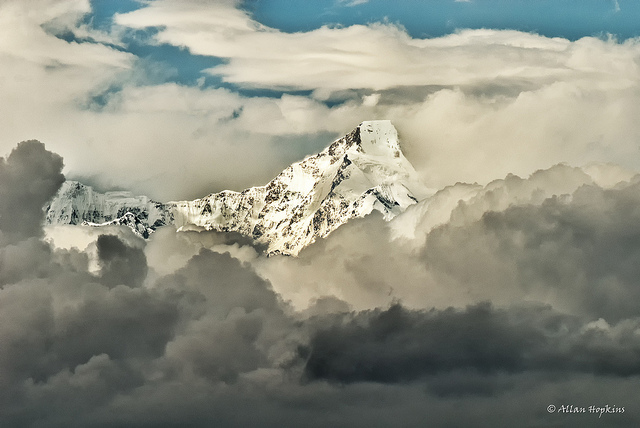Given the flash floods in India’s northern Himalayan state of Uttarakhand last year, the vagaries of the weather and the condition of the roads, there were fears that the pilgrims could get stranded. But all is well, assured officials.
No heavy rains are expected in the next few days, said Anand Sharma, head of the Uttarakhand meteorological office. The roads, though not in a very good shape after last year, are passable. And the pilgrimage is progressing smoothly.
Nanda Devi (7,818 metres), protector of shepherds and guardian of the mountain, is celebrated as the supreme spiritual goddess by the locals of the Garhwal and Kumaon regions in Uttarakhand.
Legend has it that the goddess visits her maternal dwelling in the Himalayas during August-September, which the natives celebrate by undertaking the pilgrimage. Scholars date the Yatra, or pilgrimage, back to the 9th century.
Each year thousands of pilgrims undertake this arduous 280-kilometre journey, flagged off from Nauti village in Chamoli district with much fanfare. A mythical four-horned sheep and an embellished palanquin which devotees carry to “bring the goddess back to her hometown” are an integral feature of the event.
Lavish gifts for the goddess are also carried to appease her on the 19-day trek, which terminates at Hom Kund Mount Kailash where Nanda is believed to have married Shiva. The journey must be accomplished on foot, with the devout even traversing the rock-strewn path barefoot.
An average pilgrim of the yatra is required to walk between 10 to 25 kilometres per day. This year, over 50,000 pilgrims will participate in the yatra. Apart from the trek’s tough nature, the devotees face stiff challenges in the form of ravaged trek routes and campsites following last year’s disaster. Considering the terrain’s disarray, the had requested elderly and physically fragile pilgrims to abstain from this year’s pilgrimage.
String of cancelled pilgrimages
Nature’s fury coupled with administrative ineptitude in handling pilgrim rush have resulted in the cancellation of many important yatras since 2012. The Nanda Devi yatra is already behind schedule: it was deferred in 2012 due to an inauspicious religious period (Mal Mass). In June 2013, floods again nixed the event. The Char Dham Yatra – another important pilgrimage — was also scrapped due to torrential rain. This was followed by the cancellation of the Kailash Mansarovar Yatra by the state government on August 1.
Last year, the Nanda Devi Yatra had to again be abandoned as water had swept away bridges and eroded large stretches of land along the route. As well as inconveniencing tourists, the cancellation of all these yatras led to a groundswell of angst against the state government.
“The rain menace is happening year after year,” rued Meenakshi Chabili who had signed up for the yatra last year which got cancelled at the last minute. “Why can’t the government put in place solid infrastructure and cemented trek routes so that the paths aren’t ravaged again and again? It is very disappointing to not go on the yatra if you’re so inclined.”
Worse, the state government has gradually distanced itself from organising the yatra as its arrangements have come under relentless flak from all quarters. Under pressure from the media, erstwhile Uttarakhand tourism minister, Amrita Rawat, wrote last year to the Nanda Raj Jat Committee to fix things.
The state government had also tasked a 32-member special taskforce comprising the police and Nehru Institute of Mountaineering (NIM) to inspect the Yatra’s route and suggest measures for improvement. The group – helmed by deputy chief NIM and Principal Colonel Ajay Kothiyal – recently submitted its report recommending a raft of suggestions.
Three danger routes identified by NIM can still pose a threat to pilgrims. They are slotted as `highly slippery’, `rockfall areas’ and `risky ridge’. The team also considers Zoragali Sheila Samundar route as the most dangerous as also the Bhagu Basa to Roopkund rockfall area. Among the team’s myriad suggestions are cemented treks and construction of four temporary helipad grounds.
The Uttarakhand government has also splintered the trek route into seven zones for better management. A magistrate, a deputy superintendent of police and food supply inspector has been deployed in each of them. Chief Minister Harish Rawat has earmarked 25 stopovers along the route for the pilgrims’ comfort equipped with basic amenities.
Anusuya Prasad Maikhuri, president of the Nanda Devi Raj Jat Committee, told thethirdpole.net that arrangements are in place to airlift pilgrims from high altitude in case of emergencies. “Personnel from the Kumaon and Garhwal regiments have been deployed at high Himalayan meadows to guide and rescue pilgrims if so required,’ he said. “In addition, the forest and adventure games department of the state have also been tasked to take care of the pilgrims.”
A fund of US$26 million has also been announced to erect permanent sheds on the yatra route as well as control rooms in Chamoli, Dehradun and Almora. Biometric registration of every pilgrim, limiting their number from the base camp onwards, and deployment of mobile vans along all routes are some of the other steps pressed into action for this year’s yatra.
